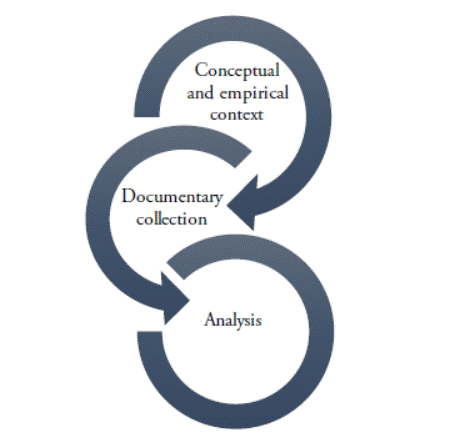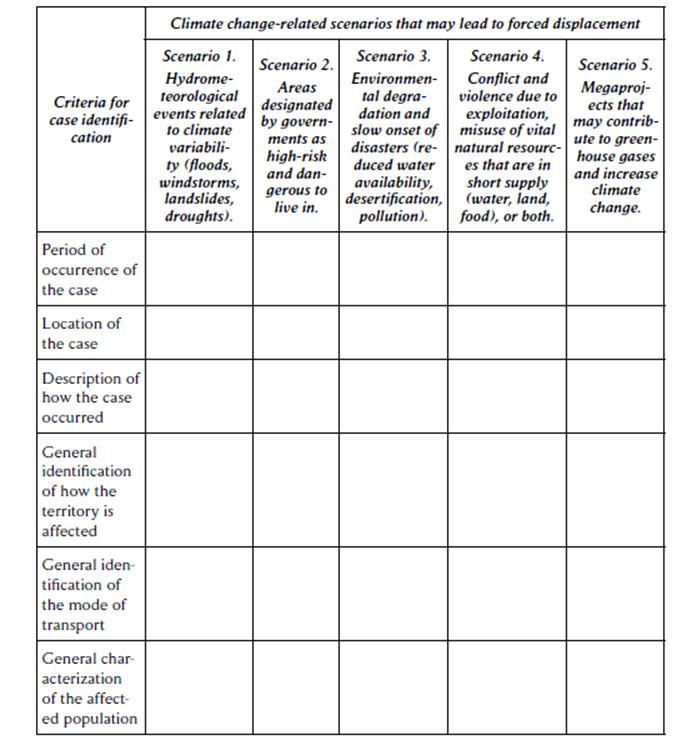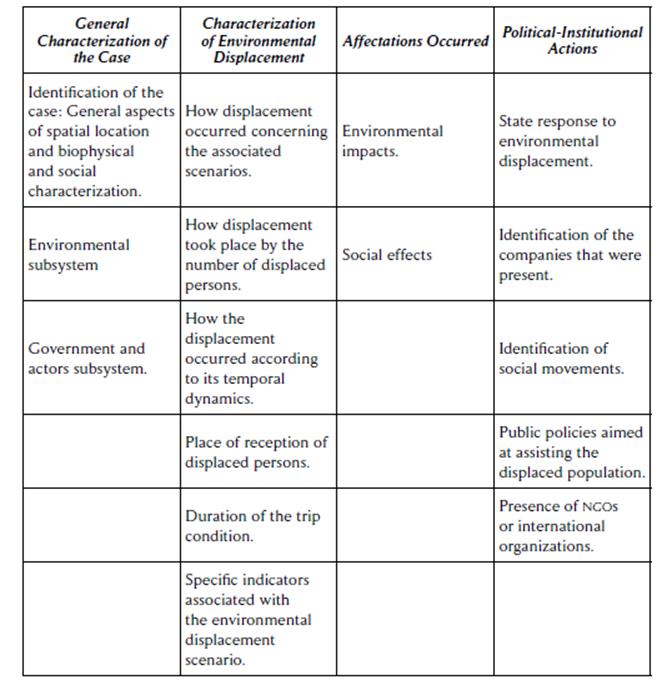Introduction
The complex relationship of society with its environment leads to drastic transformations of ecosystems, the livelihoods of human communities, and other living organisms. The changes that human societies impose on the planet, increased by the technical-scientific development of modern-world-system economies, forge a relationship with nature and the living system, generally, in the form of chrematistic appropriation where only the profit factor is determinant.
As a result of society's relationship with nature, consequences emerge (Maya, 1996), including large-scale pollution, the disappearance of species, indiscriminate logging, and climate change. All these bring about global effects, which put at risk and threaten life on the planet in the long term, not only the lives of humans but also other species that are increasingly threatened or cause their niches to disappear.
Consistently, we can affirm that one climate change risk factors is how human beings' adaptation, especially using energy produced mainly from fossil fuels that produce carbon dioxide (CO2). Additional to the generation of other greenhouse gases that have been recognized as the cause of global warming and, consequently, climate change.
For the Intergovernmental Panel on Climate Change ([IPPC], 2015):
Anthropogenic emissions of greenhouse gases have increased since the pre-industrial era, largely as a result of economic and population growth, and are now higher than ever. As a result, emissions have reached levels at least as high as they have been for the past 800000 years. The effects of emissions and other anthropogenic factors have been detected throughout the climate system. They are highly likely to have been the dominant cause of the observed warming since the second half of the [twentieth] century (p. 4).
Today's society develops economic, political, and legal principles that favor the appropriation of the natural heritage through the scientific-technical development of industrial and commercial transformation, forgetting, ignoring, or accepting the inherent risks that all these activities entail (Valencia, 2014). Thus, the stakes are environmental, social, cultural, economic, and political. For the present case, we are interested in environmental risks because one of the consequences of not having dimensioned or ignoring the dangers of industrial development is the climate change that today looms as the greatest threat to life on the planet (CISS & Unesco, 2013). To understand that environmental displacement results from different climate change factors, the climate risks presented in the coffee-growing region of Colombia during the 2010 rainy season are studied, which entailed analysis and interpretation according to the case study approach.
Colombia presents cases of human mobility due to environmental degradation. This mobility is of a forced nature. The decision to leave the places of origin is involuntary and occurs to avoid danger and safeguard life. These displacements are temporary and without a crossing international borders. However, this phenomenon was not addressed or considered legally, as with the 2010-2011 rainy season in the Eje Cafetero region, where the affected communities were categorized as victims and not displaced populations (Valencia, 2014).
Socio-Environmental Displacement Due to Climate Change
The Work Road to Survival, by the ecologist William Vogt, published in 1948 (cited in Egea & Soledad, 2011), established the first evidence of the relationship between environmental degradation and human population displacement. Later, with the emergence of the ecological movements in the 1960s, this correspondence between environmental problems and migration continued to gain ground in public debate. But it was not until 1985 that the conceptualization of human mobility processes associated with environmental issues began.
The United Nations (UN) was one of the pioneering multilateral entities recognizing human population mobility due to environmental problems-related factors. Hence, in 1985, the United Nations Environmental Program (UNEP) proposed the category of environmental refugees. This term refers to people forced to leave their traditional habitat, temporarily or permanently, due to significant environmental disruptions caused either by natural hazards or human activity. These include industrial accidents, the development of large economic projects, or migration due to poor processing and deposition of toxic waste, which endanger their existence or seriously affect their quality of life (Hinnawi, 1985, p. 4). With this first definition, the forced nature of human mobility due to environmental problems was made evident, and anthropic factors, particularly productive or economic, may be associated with this phenomenon. It also established a relationship between environmental and social issues to affect the quality of life, thus leaving an open path for linking the violation of human rights due to it.
In 2007, the International Organization for Migration (IOM) proposed the category of environmental migrant, characterized as follows: persons or groups of persons who, because of sudden or progressive changes in the environment that adversely affect their lives or living conditions, are forced to leave their usual places of residence, or decide to do so, either temporarily or permanently, and who move within their own countries or abroad (IOM, 2007; Maya, 1996. This concept adds several elements to understanding environmental displacements, such as the temporal causality of environmental change, the voluntariness or obligatory nature of leaving the place of origin, the duration of the displacement condition, and the reception areas. However, this definition does not consider the anthropic factors that can cause environmental damage, making it impossible to identify those responsible for environmental changes. Furthermore, the inclusion of voluntariness in displacement is noteworthy because people may decide to stay in their habitats or leave them. Still, if they choose to go, it will be a forced measure due to environmental change and will never be voluntary for these reasons.
It can be argued that environmental displacement manifests itself as a response to an environmental problem that may well be of natural, anthropic, or both origins in which people are forced to leave their place of residence. It may occur temporarily or permanently within their country of origin or outside its borders, endangering their lives, violating their human rights, or both (Arenas, 2002; IOM, 2007; Valencia, 2014).
Given the magnitude and increase of environmental displacement currently being registered, the association of this fact with the rise in affectations associated with climate change is being established.
Nevertheless, this association is still debated among academics and public policymakers because the impacts of climate change are planetary. Therefore, setting the occurrence of environmental displacement at the local level requires specifying its connections. In the report by Foresight (2011), the relationship between environmental displacement and climate change was shown. It stated that in 2009, 17 million people were displaced, and in 2010, 42 million were displaced for reasons associated with increased natural disasters, which the IPCC had already projected.
Altamirano (2021) argues that environmental migration occurs in three moments: 1) the appearance of environmental conditions that combine with other social and economic factors. 2) the migration process can be temporary, seasonal, or permanent. 3) Adaptation or resettlement. To further illustrate the connection between environmental displacement and climate change's new effects, Walter Kälin (2008), Representative of the Secretary-General on the Human Rights of Internally Displaced Persons of the United Nations Refugee Agency (UNHCR), identified five scenarios that may lead to environmental displacements:
Hydrometeorological disasters (floods, hurricanes/typhoons/cyclones, landslides, etc.).
Areas designated by governments as high risk and dangerous to inhabit.
Environmental degradation and slow onset of disasters (e. g, reduced water availability, desertification, recurrent flooding, salinization of coastal areas, etc.).
The case of the collapse of small island states.
Armed conflicts caused by diminishing natural resources (e. g, water, land, food) due to climate change.
According to the climate change approach, Kälin (2008) managed to locate factors of natural and anthropogenic origin to elucidate the characteristics of human mobility. In this way, and from this moment on, a platform for understanding and protecting human rights was generated.
Materials and Methods
The research approach is qualitative and stands on a socio-critical paradigm. As a methodological strategy, a case study was used to gain in-depth knowledge of the particularity and complexity of each case studied (Stake, 1998). In addition, a documentary review of governmental reports and reports of civil organizations was carried out for each scenario.
The documentary review is understood as a process in the sense that it integrates a set of strategies that allow the theoretical, conceptual, and contextual relationship with which the preparation phase was followed, where the supporting theory was defined along with the descriptive routes to perform the analysis (Valencia, 2014). A descriptive phase came next, including the review of various theoretical and conceptual references, followed by a last interpretative stage from which the reflections about these events arose (Figure 1).
Phase one. Conceptual and empirical context. The context of the cases was adapted to some scenarios Valencia (2014) proposed related to climate change that can generate environmental displacement. In addition, we added a fifth scenario according to the empirical evidence of the region: Megaprojects that can cause greenhouse gases and increase climate change and vulnerability. Based on these five scenarios, Table 1 was designed, which contains six criteria to identify the case studies in the Eje Cafetero Ecoregion.
This chart was applied in each Department that makes up the Eje Cafetero Ecoregion, choosing at least three emblematic cases per Department. Based on the characterization of each case, 15 case studies were identified. As seen in Table 1, it was necessary to cross-reference the forms and characteristics of environmental displacement with the climate change scenarios that can generate forced displacement.
Phase two. Collection of field information. In this phase, the conventional techniques of documentary review of reports, statistics, National Policy on Climate Change, and Municipal and National Development Plans, among other documents of interest, were used.
Phase three. Analysis of the information. After obtaining all the necessary information from the cases, a systematization guide was designed for the case studies, consisting of four thematic modules (Table 2). The guide systematized the field information related to the selected cases. The general characterization of the case was oriented to describe the case from the social-ecological systems approach, describing the biophysical subsystem, the social subsystem, the environmental subsystem, and the government and stakeholders' subsystem. The characterization of environmental displacement was aimed at describing the forms and scenarios of environmental displacement. Impacts Occurred describes the social and environmental impacts that were manifested in each of the environmental displacement cases. Political-institutional actions identify the responses of the State, non-governmental institutions, and communities to displacement.
Results
Fifteen cases of environmental displacement associated with climate change scenarios were identified in Colombia's Eje Cafetero Ecoregion. Their geographic location is presented in Figure 2.
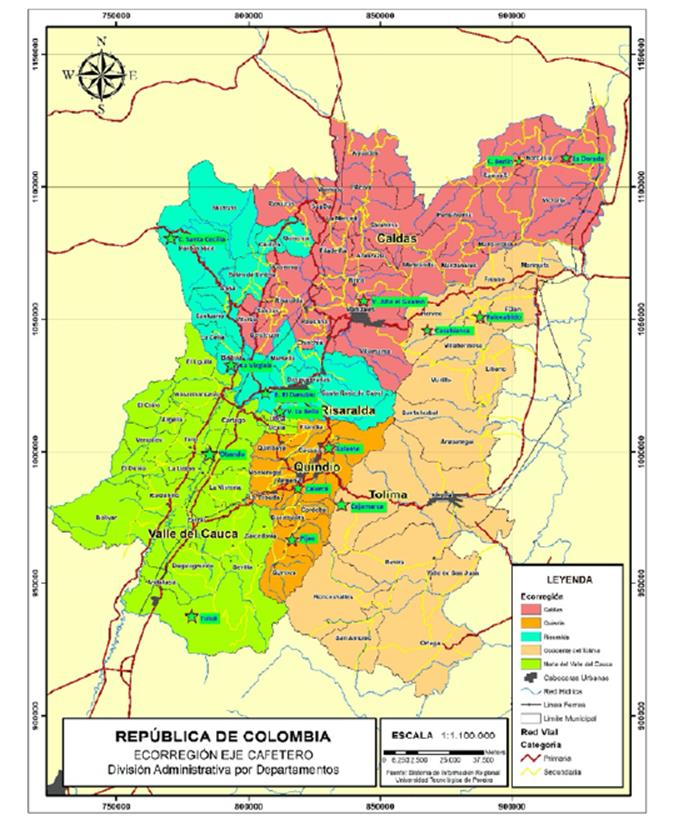
Source: Own elaboration with cartographic base from the Regional Information System of the Tecnológica de Pereira University (2008) and data from Valencia et al. (2014).
Figure 2 Location of Cases of Environmental Displacement in the Eje Cafetero Ecoregion
Socio-Environmental Displacement Cases
Scenarios of Environmental Displacement Incidence
Impact scenarios were identified based on those proposed by (Maya, 1996). Additionally, an emerging scenario called Megaprojects that may contribute to greenhouse gases and increase climate change was identified (Table 3).
Table 3 Eje Cafetero's Scenarios of Incidence of Socio-Environmental Displacement Associated with Climate Change
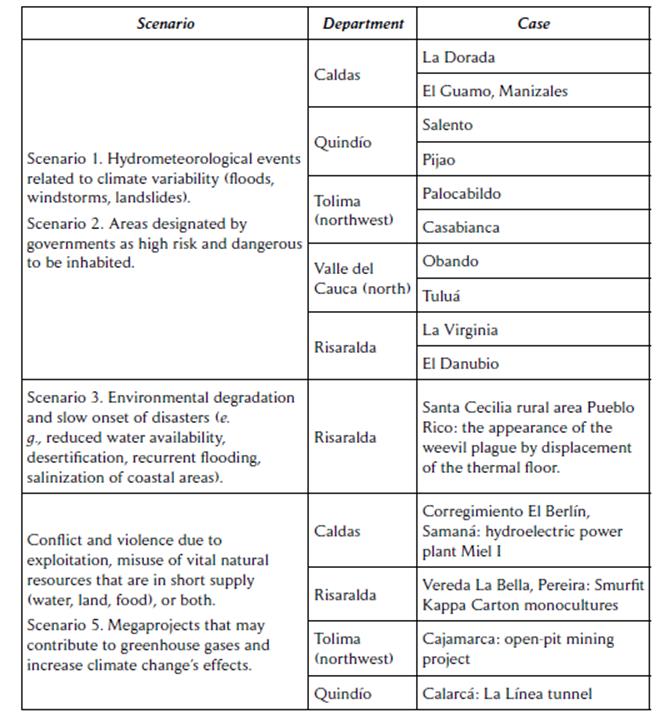
Source: Author’s with information from Valencia et al. (2014).
In scenarios 1 and 2, cases are associated with climatic variability of the 2010-2011 rainy season, during which the intensity and frequency of precipitation increased. During this event, landslides occurred in the municipalities of Pijao and Salento (Quindío), Manizales (Caldas), Palocabildo and Casabianca (Northern Tolima), and floods in La Dorada (Caldas), El Danubio in Pereira and La Virginia (Risaralda), Tuluá and Obando (Northern Valle del Cauca). In addition to the events, vulnerability factors affect the level of risk in the territories. In this sense, they shape the management of emergencies and disasters involving political-administrative decisions, land use and control, command over agricultural and livestock processes, the definition of risk zones, and other regulatory issues. An additional element to these facts is the classification of the affected areas as zones at high risk of landslides or floods in the respective land use plans, which is why these cases were placed in scenarios 1 and 2.
Scenario 3 is the case of the village of Santa Cecilia, in the municipality of Pueblo Rico (Risaralda), affected by the appearance of the insect Rhynchophorus palmarum (weevil), due to the change in the thermal floor. The temperature change in this sector caused the presence of the weevil and, with it, the reduction of the Chontaduro palm crop, which was its leading food and economic source. The explanations for this fact are attributed to the deforestation of the tropical rainforest, then pointed out as a process of environmental degradation of the area.
In scenarios 4 and 5, four cases related to the implementation of megaprojects stand out, which have affected the environment and the livelihoods of rural communities due to the contamination of water sources, the decrease in water flows, and the loss of food security. In the village of Berlín (Samaná, Caldas), displacement occurred due to the Amaní dam's construction and the transfer of the Manso River to supply the Miel I hydroelectric plant. The construction process caused the disappearance of water drains, affecting the population's food security. In addition, the humidity and temperature of the region increased, affecting their crop systems. In the case of La Bella (Pereira, Risaralda), the impact was caused by the expansion of monoculture timber plantations that have produced changes in the microclimate, degradation of the ecosystem, and the disappearance of water sources and native forests. Regarding Cajamarca (Tolima), the mining exploration carried out by a foreign company increased the municipality's vulnerability to the effects of climate change, given that this exploration was carried out in the paramo areas. Concerning Calarcá (Quindío), the population was displaced because they lived in areas at high risk of landslides, concealing the intention to vacate the area and contaminate water sources to facilitate the construction of the road infrastructure known as the Túnel de la Línea (Linea Tunnel).
Forms of Environmental Displacement
Environmental displacement is expressed systematically and gradually, as well as abruptly and suddenly. The cases referenced in scenarios 1 and 2 present a sudden and abrupt type of displacement due to the immediate effects of the 2010-2011 rainy season. On the other hand, scenarios 3, 4, and 5 present a systematic and gradual occurrence as damages accumulated over time and with the aggravating factor of the construction and implementation of hydroelectric, mining, and road projects.
Scales of occurrence of environmental displacement
The occurrence scales are established at the meso-intra-territorial and micro or in situ levels. At the meso-intra-territorial level, the cases of human migration involving a displacement from the places of settlement to nearby towns or municipalities stand out, preserving the political-administrative limits of the Department. Here we find the cases of Salento, Pijao, Obando, La Virginia, El Danubio, La Bella and Calarcá.
The populations of La Dorada, El Guamo, Palocabildo, Casabianca, Tuluá, Santa Cecilia, Berlín, and Cajamarca witnessed displacement at the micro or in situ level, in the sense that mobility took place within the same territory where the disaster occurred, without going beyond the limits of the Department.
Impacts Resulting from Environmental Displacement
In the fifteen cases referenced, the socioeconomic and environmental conditions of the populations are affected, dramatically altering their living conditions and habitability. These include social, family, and personal uprooting and violating the rights to life, personal integrity, housing, health, information, basic sanitation, water, a healthy environment, and ecological balance. Damage is caused to agricultural activities, housing, sanitation infrastructure, public utilities, access roads, and the loss of household goods, animals, and economic income.
Type of State and Social Response and Intervention
State intervention and social response are immediate concerning emergency response. State intervention prioritizes emergency response without post-facto intervention to guarantee the rehabilitation of the territories and the restitution of the rights of the affected populations. For the most part, assisting bodies are national or regional entities with a low presence of municipal authorities. This results in strictly humanitarian interventions and the definition of those affected as victims, making it impossible to provide effective and structural solutions to reestablish the rights violated due to socio-environmental displacement.
Discussion: Human Rights of Socio-Environmentally Displaced Persons
Although the category of environmentally displaced persons has not yet been recognized in the international legal framework, different organizations propose adopting normative frameworks to protect and guarantee the human rights of populations displaced by environmental problems related to climate change.
In this sense, the Interamerican Association for Environmental Defense ([AIDA], 2011) and the International Organization for the American States ([OAS], 2011) identified some human rights affected by environmental displacement associated with climate change factors, such as the right to a dignified life, to the health services system, to sanitation services, to food and means of subsistence, to access to water for consumption, to adequate housing, to the right to property and a healthy environment.
Thus, the IOM (2007) proposed adopting international standards to protect human rights and, in that sense, appealing to international law to emphasize the responsibility of States to protect the rights of their inhabitants in their territory. Similarly, it was reiterated that there are instruments of International Refugee Law and International Humanitarian Law that can also be used.
Likewise, the UNHCR (2013) stated that in these cases, it is possible to resort to International Refugee Law or the Guiding Principles on Internal Displacement, issued by the UN in 1998. The latter recognizes internally displaced persons or groups as those forced to leave their places of residence by natural or man-made disasters (Principle 2). The UNHCR affirms States are responsible for guaranteeing the protection of the human rights of environmentally displaced persons. For this reason, it set out the following challenges faced by the State when facing this phenomenon (UNHCR, 2013):
Responsibility for the causes: mitigating climate change.
Addressing impacts: reducing the risks and vulnerabilities generated by climate change.
Addressing the consequences: protecting people displaced due to climate change.
A rights-based response.
These challenges, suggested by this multilateral entity, tell States that they must concentrate on guaranteeing dignified living conditions for those at risk of displacement or displacement by climate change effects. Furthermore, it emphasizes the importance of acting under a human rights approach to the extent that it reduces the vulnerability of populations at risk and their protection from displacement.
In turn, AIDA (2011) emphasizes the need to resort to human rights institutions, such as the Inter-American Commission on Human Rights, to force States to adopt measures to prevent, mitigate, and adapt to climate change and to establish the link between climate change and human rights in public policies. As for the duties of States, it demands that the active participation of affected actors and access to information in the construction of adaptation, mitigation actions, or both be guaranteed.
For Beck (2002), the risk society is, in short, one more effect of modernity and its technological development and presupposes a constant anticipatory action of the possible unforeseen consequences of such product, which means climate change is an already foreseen consequence of development. Given its effects, it amplifies current hazards and generates new ones (IPCC, 2015), influencing present vulnerability. Still, considering its future scenarios, it exacerbates future exposure in the medium (5-15 years) and long-term (20-100 years).
Valencia (2014) proposes public policy guidelines and recommendations for environmental displacement associated with climate change aimed at including in Colombia's national legal framework the recognition of people in conditions of environmental displacement and the protection and guarantee of their human rights. These are based on the principle of participation, the rights approach, the differential approach, the principles of prevention and precaution, and environmental justice. Some of the public policy guidelines to address these cases of displacement due to climate change may be:
Expansion of protection coverage for forcibly displaced persons.
Formulation of Departmental and municipal public policy to address climate change.
Prevention of risks generating environmental forced displacement.
Recognition of environmental, political, economic, cultural, and social conflicts that cause forced environmental displacement.
Education for social awareness of environmental protection and conservation.
Monitoring and evaluation system for settlements located in risk areas.
Solidarity and collaborative work among State institutions.
Ensuring the effectiveness of the constitutional principle and fundamental right to political participation.
Access to environmental and human rights justice.
Conclusions
The risk society has allowed and forged the economic, political, legal, and social conditions for climate change and its subsequent effects to occur. The emergence of the displacement of people as a consequence of factors associated with climate change is one of the effects expected but not mitigated by the risk society, despite the announcements made by civil society and scientists since the 1940s.
There is sufficient evidence that climate change exacerbates the phenomena related to climate variability and thus increases the likelihood that people and communities will be forcibly displaced.
In Colombia, there is still no normative recognition of the environmentally displaced. The Colombian State only recognizes the concept of victims by referring to the population affected by a natural or climatic disaster. Therefore, policies are oriented toward emergency assistance, not the comprehensive restoration of rights.
In the Colombian regulatory framework, international instruments such as the Principles of the Peninsula on climate displacement within States could be considered, which offer special protection to populations in conditions of vulnerability. Also, highlight the Nansen Initiative that protects and assists displaced persons in the context of disasters. As well as The Sendai Framework for Disaster Risk Reduction 2015-2030 in which States are responsible for reducing disaster risks and guaranteeing responses to recovery, rehabilitation and reconstruction (García, 2019).
The population affected by the factors associated with climate change must overcome the condition of victims and be recognized as victims of the effects of climate change.
Human populations and ecosystems have different levels of exposure and vulnerability to climate change. Hence, the forms in which displacement occurs are diverse, according to ecosystemic, territorial, social, and political dynamics.
The current model of planetary socio-economic development and how human beings adapt in the territories are generating ecosystemic and social imbalances that put at risk and increase the vulnerability of people and the living system in the face of the effects of climate change.














